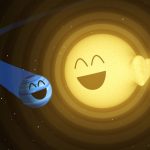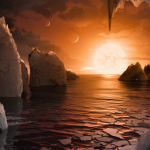EXOPLANETS
New Unistellar eVscope exoplanet light curve and exoplanet targets this weekend!

Dear Unistellar eVscope users,
With your Unistellar eVscope you have the technology to detect planets orbiting other stars. Think about this--over 30 years ago planets around other stars (exoplanets) were hypothesized, but none yet were detected. Since the most agreed upon "first detection" of an exoplanet in 1992 around a pulsar, astronomers have detected thousands of exoplanets, but this has been done mostly through the use of expensive remote telescopes and highly technical techniques. Now, you and your eVscope can observe exoplanets with a few clicks on your smartphone and some time.
I've been posting exoplanet targets for you and me to... read more ❯
Look up and let the stars lift your spirits AND exoplanet targets for Unistellar eVscope users!

Dear Cosmic Diary guests and Unistellar eVscope users,
My heart and best wishes go out to you and to your families during the COVID-19 global crisis. I have been very busy adjusting to this new way of life in quarantine and social distancing to do my part in "flattening the curve" and staying safe, as I'm sure many of you also have.
In addition to being a PhD student, I also teach high school physics full-time and my school in the Bay Area, CA, closed down for the pandemic on Friday, March 13. My teacher colleagues and I began teaching completely online... read more ❯
TONIGHT: NASA TESS exoplanet target for Unistellar eVscope users on March 7.

Dear Unistellar eVscope users,
Since it was very cloudy last night in California, I thought I'd post another target since forecasts predict only partly cloudy skies tonight. Be sure to check your weather, and be especially careful for any rain, but if the stars align, then go get some exoplanet data!!! 😉
Background Information (skip to the observing directions, if you've seen this before)
If you have not seen my previous posts on this topic, my name is Dan Peluso and I am doing my PhD in astrophysics with Franck Marchis (astronomer at the SETI Institute) and as a portion of my research... read more ❯
March 6 Weekend Edition: Get your Unistellar eVscopes and help observe NASA TESS exoplanets!

Dear Unistellar eVscope users,
It's time for another Unistellar eVscope exoplanet citizen science campaign. We would love your help observing some exoplanets, so if you want to join us in some planet hunting, then charge up your eVscopes and get ready because we need your help this weekend!
Background Information (skip to the observing directions, if you've seen this before)
If you have not seen my previous posts on this topic, my name is Dan Peluso and I am doing my PhD in astrophysics with Franck Marchis (astronomer at the SETI Institute) and as a portion of my research I want to see if... read more ❯
Feb. 14 - Feb 22 Weekend Edition: Get your Unistellar eVscopes and help observe exoplanets!

Dear Unistellar eVscope users,
It's time for another Unistellar eVscope exoplanet citizen science campaign. We would LOVE (Happy Valentine's Day by the way) your help observing some exoplanets, so if you want to join us in some planet hunting, then charge up those eVscopes and get ready because we need your help over the next few weekends!
If you didn't catch my recent posts on this topic, my name is Dan Peluso and I am doing my PhD in astrophysics with Franck Marchis (astronomer at the SETI Institute) and as a portion of my research I want to see if it is... read more ❯
Feb. 1 - Feb. 9 Weekend Edition: Get your Unistellar eVscopes and help observe exoplanets!

Dear Unistellar eVscope users,
It's time for another Unistellar eVscope exoplanet citizen science campaign. We would love your help observing some exoplanets, so if you want to join us in some planet hunting, then charge up those eVscopes and get ready because we need your help over the next few weekends!
If you didn't catch my recent posts on this topic, my name is Dan Peluso and I am doing my PhD in astrophysics with Franck Marchis (astronomer at the SETI Institute) and as a portion of my research I want to see if it is possible for any astronomy enthusiast around... read more ❯
January 24 Edition: Get your Unistellar eVscopes and help observe a NASA TESS exoplanet TONIGHT!

Dear Unistellar eVscope users,
Today is my birthday and for a gift, I want you to be involved in something innovative like participating in the very first second Unistellar exoplanet detection campaign? Then charge up those eVscopes and get ready because we need your help tonight to try and observe a NASA TESS exoplanet!
If you didn't catch my last post on this topic, my name is Dan Peluso and I am doing my PhD in astrophysics with Franck Marchis (astronomer at the SETI Institute) and as a portion of my research I want to see if it is possible for any astronomy... read more ❯
Get your Unistellar eVscopes and help observe an exoplanet this weekend!

Dear Unistellar eVscope users,
Want to be involved in something innovative like participating in the very first Unistellar exoplanet detection campaign? Then charge your eVscope and get ready because we need your help this weekend!
My name is Dan Peluso and I am doing my PhD in astrophysics with Franck Marchis (astronomer at the SETI Institute) and as a portion of my research I want to see if it is possible for any astronomy enthusiast around the world to coordinate with planet hunting scientists like us to help contribute to the search for planets around other stars (a.k.a. exoplanets). Exoplanet searches usually... read more ❯
The exoplanet Beta Pictoris b. And yet it moves

Eric Nielsen, formerly a post-doc at the SETI Institute and now a researcher at Stanford University, led a study of the planet beta Pictoris b that combined direct observation of the planet recorded with the Gemini Planet Imager with additional data from space and ground-based observations. The team estimated the mass of this distant planet to be eight to sixteen times that of Jupiter and found that it likely has an elliptical orbit. A video shows the motion of the planet around its star, something that was inconceivable fifteen years ago.
Since it was installed on the Gemini-South telescope in 2013,... read more ❯
Finding Kuiper Belt 2.0

A team of astronomers led by Bin Ren (The Johns Hopkins University) imaged the debris disk system around star HD 191089 using the GPI instrument, located at 160 light-year away from us. The structure of the debris disk around this younger sibling of our Sun is strikingly similar to our own Kuiper Belt. New technology available maybe in 2030s, like the giant space telescopes (HabEx & LUVOIR) could one day tell if there is also an Earth 2.0 with the Belt delivering water right now, or is there an exotic world that we have never seen or imagined, or maybe... read more ❯
Wonderful Potentially Habitable Worlds Around TRAPPIST-1

In May 2016, Michael Gillon and his team announced the discovery of three Earth-sized exoplanets around TRAPPIST-1, an ultra cool M-dwarf star, using the small TRAPPIST telescope at ESO-La Silla, Chile. It was an exciting discovery—yet on that day no one could possibly have imagined that less than a year later they would make another significant discovery involving the same system. But here we are: today, they announced in Nature the discovery of seven potentially habitable Earth-like worlds.
The star, named TRAPPIST-1, is a fairly inconspicuous star in our Milky Way.... read more ❯
AGU 2015 session: Direct Imaging of Habitable Exoplanets: Progress and Future
Join us tomorrow at the AGU Fall Meeting for a session on direct imaging of habitable exoplanets that I organized with my colleagues Ramses Ramirez from Cornell University and David Black.
This session consists in a discussion on the potential of new and future facilities and modeling efforts designed to detect, image and characterize habitable exoplanets, studying their formation, evolution and also the existence of possible biospheres. Topics to be covered in this session include signs of exoplanet habitability and global biosignatures that can be sought with upcoming... read more ❯
Gemini Planet Imager Exoplanet Survey -- One Year Into The Survey
Thursday, November 12 2015 - 9:00 am, PST
AAS/SETI Institute press release presented at the DPS 2015 at National Harbor, MD, USA
The Gemini Planet Imager Exoplanet Survey (GPIES)... read more ❯
What do we know about planet formation?

Understanding how planets form in the Universe is one of the main motivations for GPI. Thanks to its advanced design, GPI specializes in finding and studying giant planets that are similar to Jupiter in our solar system. These are the kind of planets whose origin we hope to understand much better after our survey is complete.
We know that planets form within protoplanetary disks that orbit young stars, and gas giants need to be fully formed within 3-10 million years... read more ❯
What Self-Luminous Planets are Like
The planets that we are familiar with in our own solar system have evolved, aged, and cooled, for over 4.5 billion years since the Sun and planets formed. What do planets look like at younger ages? Can we use the light that a planet emits to understand its past history?
When we look at a planet like Jupiter with our eyes, the light that we see is Sunlight that is reflected back to us at Earth, scattered by clouds and gasses in the planet’s atmosphere. But what would Jupiter look like if we instead could see only its thermal “heat” emission,... read more ❯
